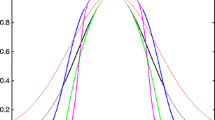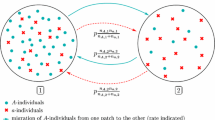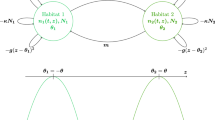Abstract
Ecological interaction, including competition for resources, often causes frequency-dependent disruptive selection, which, when accompanied by reproductive isolation, may act as driving forces of adaptive speciation. While adaptive dynamics models have added new perspectives to our understanding of the ecological dimensions of speciation processes, it remains an open question how best to incorporate and analyze genetic detail in such models. Conventional approaches, based on quantitative genetics theory, typically assume a unimodal character distribution and examine how its moments change over time. Such approximations inevitably fail when a character distribution becomes multimodal. Here, we propose a new approximation, oligomorphic dynamics, to the quantitative genetics of populations that include several morphs and that therefore exhibit multiple peaks in their character distribution. To this end, we first decompose the character distribution into a sum of unimodal distributions corresponding to individual morphs. Characterizing these morphs by their frequency (fraction of individuals belonging to each morph), position (mean character of each morph), and width (standard deviation of each morph), we then derive the coupled eco-evolutionary dynamics of morphs through a double Taylor expansion. We show that the demographic, convergence, and evolutionary stability of a population’s character distribution correspond, respectively, to the asymptotic stability of frequencies, positions, and widths under the oligomorphic dynamics introduced here. As first applications of oligomorphic dynamics theory, we analytically derive the effects (a) of the strength of disruptive selection on waiting times until speciation, (b) of mutation on conditions for speciation, and (c) of the fourth moments of competition kernels on patterns of speciation.
Similar content being viewed by others
References
Abrams PA, Matsuda H, Harada Y (1993) Evolutionarily unstable fitness maxima and stable fitness minima of continuous traits. Evol Ecol 7: 465–487
Barton NH, Turelli M (1991) Natural and sexual selection on many loci. Genetics 127: 229–255
Bonsall MB, Jansen VAA, Hassell MP (2004) Life history trade-offs assemble ecological guilds. Science 306: 111–114
Boots M, Haraguchi Y (1999) The evolution of costly resistance in host–parasite systems. Am Nat 153: 359–370
Boots M, Hudson PJ, Sasaki A (2004) Large shifts in pathogen virulence relate to host population structure. Science 303: 842–844
Bowers RG, White A, Boots M, Geritz SAH, Geritz SAH (2003) Evolutionary branching/speciation: contrasting results from systems with explicit or emergent carrying capacities. Evol Ecol Res 5: 883–891
Brown JS, Pavlovic NB (1992) Evolution in heterogeneous environments: effects of migration on habitat specialization. Evol Ecol 6: 360–382
Brown JS, Vincent TL (1987) A theory for the evolutionary game. Theor Popul Biol 31: 140–166
Bull JJ (1987) Evolution of phenotypic variance. Evolution 41: 303–315
Bulmer MG (1972) The genetic variability of polygenic characters under optimizing selection, mutation and drift. Genet Res 19: 17–25
Bulmer M (1974) Density-dependent selection and character displacement. Am Nat 108: 45–58
Bulmer MG (1992) The mathematical theory of quantitative genetics. Oxford University Press, Oxford
Cheptou PO, Mathias A (2001) Can varying inbreeding depression select for intermediary selfing rate?. Am Nat 157: 361–373
Chow SS, Wilke CO, Ofria C, Lenski RE, Adami C (2004) Adaptive radiation from resource competition in digital organisms. Science 305: 84–86
Claessen D, Dieckmann U (2002) Ontogenetic niche shifts and evolutionary branching in size-structured populations. Evol Ecol Res 4: 189–217
Cohen D, Levin SA (1991) Dispersal in patchy environments: the effect of temporal and spatial structure. Theor Popul Biol 39: 63–99
Day T (2000) Competition and the effect of spatial resource heterogeneity on evolutionary diversification. Am Nat 155: 790–803
Day T, Young KA (2004) Competitive and facilitative evolutionary diversification. BioScience 54: 101–109
De Jong T, Geritz SAH (2001) The role of geitonogamy in the gradual evolution towards dioecy in cosexual plants. Selection 2: 133–146
Dercole F (2003) Remarks on branching-extinction evolutionary cycles. J Math Biol 47: 569–580
Dieckmann U, Doebeli M (1999) On the origin of species by sympatric speciation. Nature 400: 354–357
Dieckmann U, Doebeli M (2005) Pluralism in evolutionary theory. J Evol Biol 18: 1209–1213
Dieckmann U, Law R (1996) The dynamical theory of coevolution: a derivation from stochastic ecological processes. J Math Biol 34: 579–612
Dieckmann, U, Doebeli, M, Metz, JAJ, Tautz, D (eds) (2004) Adaptive speciation. Cambridge University Press, Cambridge
Doebeli M (1996) An explicit genetic model for ecological character displacement. Ecology 77: 510–520
Doebeli M (1996) A quantitative genetic model for sympatric speciation. J Evol Biol 9: 893–909
Doebeli M (2002) A model for the evolutionary dynamics of cross-feeding polymorphisms in microorganisms. Popul Ecol 44: 59–70
Doebeli M, Dieckmann U (2000) Evolutionary branching and sympatric speciation caused by different types of ecological interactions. Am Nat 156(suppl.): S77–S101
Doebeli M, Dieckmann U (2003) Speciation along environmental gradients. Nature 421: 259–264
Doebeli M, Hauert C, Killingback T (2004) The evolutionary origin of cooperators and defectors. Science 306: 859–862
Doebeli M, Ruxton GD (1997) Evolution of dispersal rates in metapopulation models: branching and cyclic dynamics in phenotype space. Evolution 51: 1730–1741
Doebeli M, Blok HJ, Leimar O, Dieckmann U (2007) Multimodal pattern formation in phenotype distributions of sexual populations. Proc R Soc Lond B Biol Sci 274: 347–357
Egas M, Dieckmann U, Sabelis MW (2004) Evolution restricts the coexistence of specialists and generalists: the role of trade-off structure. Am Nat 163: 518–531
Egas M, Sabelis MW, Dieckmann U (2005) Evolution of specialization and ecological character displacement of herbivores along a gradient of plant quality. Evolution 59: 507–520
Ellner S, Hairston NG (1994) Role of overlapping generations in maintaining genetic- variation in a fluctuating environment. Am Nat 143: 403–417
Ellner S, Sasaki A (1996) Patterns of genetic polymorphism maintained by fluctuating selection with overlapping generations. Theor Popul Biol 50: 31–65
Ernande B, Dieckmann U (2004) The evolution of phenotypic plasticity in spatially structured environments: implications of intraspecific competition, plasticity costs and environmental characteristics. J Evol Biol 17: 613–628
Eshel I (1983) Evolutionary and continuous stability. J Theor Biol 103: 99–111
Eshel I, Motro U (1981) Kin selection and strong evolutionary stability of mutual help. Theor Popul Biol 19: 420–433
Falconer DS (1996) Introduction to quantitative genetics. Longman, Harlow
Felsenstein J (1976) The theoretical population genetics of variable selection and migration. Annu Rev Ecol Syst 10: 253–280
Ferdy JB, Després L, Godelle B (2002) Evolution of mutualism between globeflowers and their pollinating flies. J Theor Biol 217: 219–234
Ferrière R, Bronstein JL, Rinaldi S, Law R, Gauduchon M (2002) Cheating and the evolutionary stability of mutualisms. Proc R Soc Lond B Biol Sci 269: 773–780
Fort H, Scheffer M, Van Nes EH (2009) The paradox of the clumps mathematically explained. Theor Ecol 2: 171–176
Geritz SAH, Kisdi É, Meszéna G, Metz JAJ (1998) Evolutionarily singular strategies and the adaptive growth and branching of the evolutionary tree. Evol Ecol 12: 35–57
Geritz SAH, Van der Meijden E, Metz JAJ (1999) Evolutionary dynamics of seed size and seedling competitive ability. Theor Popul Biol 55: 324–343
Gudelj I, van den Bosch F, Gilligan CA (2004) Transmission rates and adaptive evolution of pathogens in sympatric heterogeneous plant populations. Proc R Soc Lond B Biol Sci 271: 2187–2194
Gyllenberg M, Meszéna G (2005) On the impossibility of coexistence of infinitely many strategies. J Math Biol 50: 133–160
Haraguchi Y, Sasaki A (1996) Host–parasite arms race in mutation modifications: indefinite escalation despite a heavy load?. J Theor Biol 183: 121–137
Haraguchi Y, Sasaki A (1997) Evolutionary pattern of intra-host pathogen antigenic drift: effect of cross-reactivity in immune response. Philos Trans R Soc Lond B Biol Sci 352: 11–20
Iwanaga A, Sasaki A (2004) Evolution of hierarchical cytoplasmic inheritance in the plasmodial slime mold Physarum polycephalum. Evolution 58: 710–722
Iwasa Y, Pomiankowski A, Nee S (1991) The evolution of costly mate preferences. II. The ‘handicap’ principle. Evolution 45: 1431–1442
Jansen VAA, Mulder GSEE (1999) Evolving biodiversity. Ecol Lett 2: 379–386
Johst K, Doebeli M, Brandl R (1999) Evolution of complex dynamics in spatially structured populations. Proc R Soc Lond B Biol Sci 266: 1147–1154
Kamo M, Sasaki A, Boots M (2007) The role of trade-off shapes in the evolution of parasites in spatial host populations: an approximate analytical approach. J Theor Biol 244: 588–596
Kimura M, Crow JF (1964) The number of alleles that can be maintained in a finite population. Genetics 49: 725–738
Kisdi É (1999) Evolutionary branching under asymmetric competition. J Theor Biol 197: 149–162
Kisdi É (2001) Long-term adaptive diversity in Levene-type models. Evol Ecol Res 3: 721–727
Kisdi É, Geritz SAH (2001) Evolutionary disarmament in interspecific competition. Proc R Soc Lond B Biol Sci 268: 2589–2594
Kisdi É, Jacobs FJA, Geritz SAH (2001) Red queen evolution by cycles of evolutionary branching and extinction. Selection 2: 161–176
Koella JC, Doebeli M (1999) Population dynamics and the evolution of virulence in epidemiological models with discrete host generations. J Theor Biol 198: 461–475
Kondrashov AS, Yampolsky LY (1996) High genetic variability under the balance between symmetric mutation and fluctuating stabilizing selection. Genet Res 68: 157–164
Lande R (1975) The maintenance of genetic variability by mutation in a polygenic character with linked loci. Genet Res 26: 221–235
Lande R (1976) Natural selection and random genetic drift in phenotypic evolution. Evolution 30: 314–334
Lande R (1979) Quantitative genetic-analysis of multivariate evolution, applied to brain—body size allometry. Evolution 33: 402–416
Lande R (1981) Models of speciation by sexual selection on polygenic traits. Proc Natl Acad Sci USA 78: 3721–3725
Lande R (1982) A quantitative genetic theory of life history evolution. Ecology 63: 607–615
Lande R (1985) Expected time for random genetic drift of a population between stable phenotypic states. Proc Natl Acad Sci USA 82: 7641–7645
Lande R (1986) The dynamics of peak shifts and the pattern of morphological evolution. Paleobiology 12: 343–354
Lande R, Kirkpatrick M (1988) Ecological speciation by sexual selection. J Theor Biol 133: 85–98
Law R, Bronstein JL, Ferrière R (2001) On mutualists and exploiters: plant-insect coevolution in pollinating seed–parasite systems. J Theor Biol 212: 373–389
Law R, Marrow P, Dieckmann U (1997) On evolution under asymmetric competition. Evol Ecol 11: 485–501
Leimar O (2005) The evolution of phenotypic polymorphism: randomized strategies versus evolutionary branching. Am Nat 165: 669–681
Leimar O, Doebeli M, Dieckmann U (2008) Evolution of phenotypic clusters through competition and local adaptation along an environmental gradient. Evolution 62: 807–822
Levin SA, Cohen D, Hastings A (1984) Dispersal strategies in patchy environment. Theor Popul Biol 19: 169–200
Loeuille N, Loreau M (2005) Evolutionary emergence of size structured food webs. Proc Natl Acad Sci USA 102: 5761–5766
Ludwig D, Levin SA (1991) Evolutionary stability of plant communities and the maintenance of multiple dispersal types. Theor Popul Biol 40: 285–307
MacArthur R (1969) Species packing, and what interspecies competition minimizes. Proc Natl Acad Sci USA 64: 1369–1371
MacArthur R (1970) Species packing and competitive equilibrium for many species. Theor Popul Biol 1: 1–11
MacArthur R, Levins R (1967) The limiting similarity, convergence, and divergence of coexisting species. Am Nat 101: 377–385
Maire N, Ackermann M, Doebeli M (2001) Evolutionary branching and the evolution of anisogamy. Selection 2: 119–132
Matessi C, Jayakar SD (1981) Coevolution of species in competition—a theoretical study. Proc Natl Acad Sci USA 78: 1081–1084
Matsuda H, Abrams PA (1999) Why are equally sized gametes so rare? The instability of isogamy and the cost of anisogamy. Evol Ecol Res 1: 769–784
Mathias A, Kisdi É (2002) Adaptive diversification of germination strategies. Proc R Soc Lond B Biol Sci 269: 151–156
Mathias A, Kisdi É, Olivieri I (2001) Divergent evolution of dispersal in a heterogeneous landscape. Evolution 55: 246–259
May RM (1973) Stability and complexity in model ecosystems. Princeton University Press, Princeton
May RM (1974) On the theory of niche overlap. Theor Popul Biol 5: 297–332
Maynard Smith J (1982) Evolution and the theory of games. Cambridge University Press, Cambridge
Meszéna G, Czibula I, Geritz SAH (1997) Adaptive dynamics in a 2-patch environment: a toy model for allopatric and parapatric speciation. J Biol Syst 5: 265–284
Meszéna G, Szathmáry E (2001) Adaptive dynamics of parabolic replicators. Selection 2: 147–160
Metz JAJ, Geritz SAH, Meszéna G, Jacobs FJA, van Heerwaarden JS (1996) Adaptive dynamics: a geometrical study of the consequences of nearly faithful reproduction. In: Strien SJ, Verduyn Lunel SM (eds) Stochastic and spatial structures of dynamical systems. North-Holland, Amsterdam, pp 183–231
Metz JAJ, Nisbet RM, Geritz SAH (1992) How should we define “fitness” for general ecological scenarios?. Trends Ecol Evol 7: 198–202
Newman CM, Cohen JE, Kipnis C (1985) Neo-darwinian evolution implies punctuated equilibria. Nature 315: 400–401
Parvinen K (1999) Evolution of migration in a metapopulation. Bull Math Biol 61: 531–550
Parvinen K, Egas M (2004) Dispersal and the evolution of specialisation in a two-habitat type metapopulation. Theor Popul Biol 66: 233–248
Pigolotti S, López C, Hernández-García E (2007) Species clustering in competitive Lotka-Volterra models. Phys Rev Lett 98: 258101
Pigolotti S, López C, Hernández-García E, Andersen KH (2009) How Gaussian competition leads to lumpy or uniform species distributions. Theor Ecol 3: 89–96
Rees M, Westoby M (1997) Game-theoretical evolution of seed mass in multi-species ecological models. Oikos 78: 116–126
Regoes RR, Nowak MA, Bonhoeffer S (2000) Evolution of virulence in a heterogeneous host population. Evolution 54: 64–71
Reuter M, Helms KR, Lehmann L, Keller L (2004) Effects of brood manipulation costs on optimal sex allocation in social Hymenoptera. Am Nat 164: E73–E82
Roughgarden J (1972) Evolution of niche width. Am Nat 106: 683–718
Roughgarden J (1976) Resource partitioning among competing species—a coevolutionary approach. Theor Popul Biol 9: 388–424
Rosenzweig ML (1978) Competitive speciation. Biol J Linn Soc 10: 275–289
Sasaki A (1997) Clumped distribution by neighborhood competition. J Theor Biol 186: 415–430
Sasaki A, de Jong G (1999) Density dependence and unpredictable selection in a heterogeneous environment: compromise and polymorphism in the ESS reaction norm. Evolution 53: 1329–1342
Sasaki A, Ellner S (1995) The evolutionarily stable phenotype distribution in a random environment. Evolution 49: 337–350
Sasaki A, Ellner S (1997) Quantitative genetic variance maintained by fluctuating selection with overlapping generations: variance components and covariances. Evolution 51: 682–696
Sasaki A, Godfray HCJ (1999) A model for the coevolution of resistance and virulence in coupled host–parasitoid interactions. Proc R Soc Lond B 266: 455–463
Schreiber SJ, Tobiason GA (2003) The evolution of resource use. J Math Biol 47: 56–78
Slatkin M (1979) Frequency-dependent and density-dependent selection on a quantitative character. Genetics 93: 755–771
Slatkin M (1980) Ecological character displacement. Ecology 61: 163–177
Slatkin M, Lande R (1976) Niche width in a fluctuating environment-density independent model. Am Nat 110: 31–55
Szabó P, Meszéna G (2006) Limiting similarity revisited. Oikos 112: 612–619
Taper ML, Case TJ (1985) Quantitative genetic models for the coevolution of character displacement. Ecology 66: 355–371
Taylor P, Day T (1997) Evolutionary stability under the replicator and the gradient dynamics. Evol Ecol 11: 579–590
Troost TA, Kooi BW, Kooijman SALM (2005) Ecological specialization of mixotrophic plankton in a mixed water column. Am Nat 166: E45–E61
Turelli M (1984) Heritable genetic variation via mutation-selection balance: Lerch’s zeta meets the abdominal bristle. Theor Popul Biol 25: 138–193
Van der Laan JD, Hogeweg P (1995) Predator–prey coevolution: interactions across different timescales. Proc R Soc Lond B Biol Sci 259: 35–42
Van Dooren TJM, Leimar O (2003) The evolution of environmental and genetic sex determination in fluctuating environments. Evolution 57: 2667–2677
Van Doorn GS, Luttikhuizen PC, Weissing FJ (2001) Sexual selection at the protein level drives the extraordinary divergence of sex-related genes during sympatric speciation. Proc R Soc Lond B Biol Sci 268: 2155–2161
Van Doorn GS, Dieckmann U, Weissing FJ (2004) Sympatric speciation by sexual selection: a critical re-evaluation. Am Nat 163: 709–725
Vincent TL, Cohen Y, Brown JS (1993) Evolution via strategy dynamics. Theor Popul Biol 44: 149–176
Whitlock MC (1995) Variance-induced peak shifts. Evolution 49: 252–259
Whitlock MC (1997) Founder effects and peak shifts without genetic drift: adaptive peak shifts occur easily when environments fluctuate slightly. Evolution 51: 1044–1048
Author information
Authors and Affiliations
Corresponding author
Rights and permissions
About this article
Cite this article
Sasaki, A., Dieckmann, U. Oligomorphic dynamics for analyzing the quantitative genetics of adaptive speciation. J. Math. Biol. 63, 601–635 (2011). https://doi.org/10.1007/s00285-010-0380-6
Received:
Revised:
Published:
Issue Date:
DOI: https://doi.org/10.1007/s00285-010-0380-6
Keywords
- Adaptive dynamics
- Quantitative genetics theory
- Moment dynamics
- Adaptive speciation
- Evolutionarily stable strategy
- Convergence stability




